
Aerobatics is the practice of flying maneuvers involving aircraft attitudes that are not used in conventional passenger-carrying flights. The term is a portmanteau of "aeroplane" and "acrobatics". Aerobatics are performed in aeroplanes and gliders for training, recreation, entertainment, and sport. Additionally, some helicopters, such as the MBB Bo 105, are capable of limited aerobatic manoeuvres. An example of a fully aerobatic helicopter, capable of performing loops and rolls, is the Westland Lynx.

Walter Extra is a German award-winning aerobatic pilot and chief aircraft designer who founded the aerobatic aircraft manufacturer Extra Flugzeugbau.

Curtis Hardeman Pitts was an American aircraft designer, aircraft manufacturer, crop duster, and airport fixed-base operator. He became widely known and revered in the aerobatics community for his design of the Pitts Special, a series of highly aerobatic biplanes. Pitts Specials dominated aerobatic competition from the 1960's to the 1970's. Though later outclassed by newer monoplane designs, Pitts Specials remain popular as sport airplanes for their excellent flying qualities. The Smithsonian Institution's National Air and Space Museum in Washington, DC has called Curtis Pitts' design "revolutionary because of its small size, light weight, short wingspan and extreme agility".
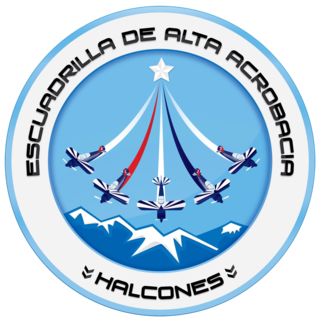
Escuadrilla de Alta Acrobacia Halcones, known simply as the 'Hawks' (Halcones), is an active group of nine officers of the Chilean Air Force who are trained specifically for aerobatics. One of the Halcones' signature moves is recreating the Chilean star in the air using smoke. The team may be likened to the British Royal Air Force's Red Arrows for their affinity for complex, high-risk, aviation-based manoeuvers.
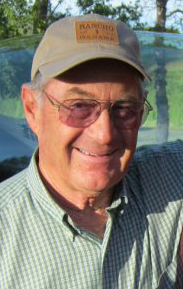
Wayne Handley is an American airshow performer, former naval aviator, agricultural pilot, Aerobatic Competency Evaluator (ACE), and coach for upcoming and current airshow stars. Handley and his wife Karen are former residents of the Salinas Valley of California, and Groveland, California who currently reside in Monterey, California
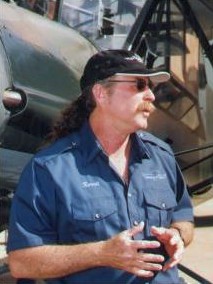
Kermit Weeks is an American aviation enthusiast, pilot, and aircraft collector. He has competed in aerobatics, designed aircraft, and promoted aviation and vintage aircraft restoration.

Frank Versteegh is a Dutch aerobatics pilot. He is also an airshow organiser, a flight safety committee member, a FAI judge and a freestyle aerobatics competitor.

Michael George "Mike" Goulian is an American aerobatic national champion aviator who raced in the Red Bull Air Race World Series under the number 99.
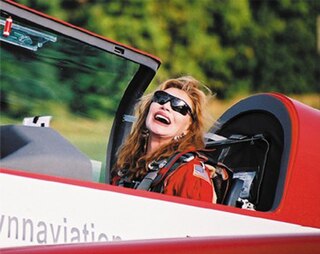
Nancy A. Lynn was an aerobatic pilot, flight instructor, and air show performer. She owned and operated Lynn Aviation, an aerobatic flight school located at Bay Bridge Airport in Stevensville, Maryland, with her husband Scott Muntean and son Pete.
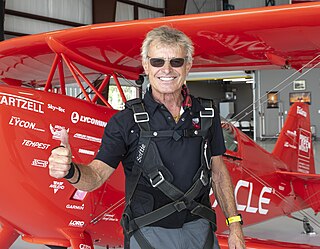
Sean Doherty Tucker is an American world champion aerobatic aviator. He was previously sponsored by the Oracle Corporation for many years, performing in air shows worldwide as "Team Oracle". Tucker has won numerous air show championship competitions throughout his career, was named one of the 25 "Living Legends of Flight" by the Smithsonian's National Air and Space Museum in 2003, and was inducted into the National Aviation Hall of Fame in 2008. He has led several efforts to assist youth in learning to fly or becoming involved in general aviation, and currently serves as co-chairman of the Experimental Aircraft Association (EAA)'s Young Eagles program, a role he has held since 2013.
Charlie Hillard was an American aerobatics pilot, and the first American to win the world aerobatics title.
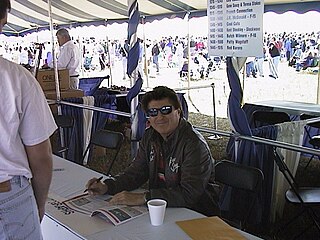
Gene Soucy is an American aerobatics pilot. The son of two pilots, he would wash airplanes at a local airport in exchange for flight time while growing up in Kentucky. He soloed in a glider at age 14, and in a regular airplane at 16.
Matt Hall is a third-generation pilot, a former Royal Australian Air Force (RAAF) fighter combat instructor, international unlimited aerobatic competitor and the first Australian to be selected to compete in the Red Bull Air Race World Championship, starting in 2009 with his team Matt Hall Racing. He won the championship in the final season of Red Bull Air Race in 2019.
Neil Williams was a Welsh aerobatics pilot.

Marion Cole (1924–2011) was an American Aerobatic pilot.

Ali İsmet Öztürk is a Turkish professional display pilot, an aerobatic aircraft designer and an aviation businessman. He is the first civilian to be recognised as a professional aerobatic pilot in the country. He flies in international air shows in his custom designed and manufactured world-class performance aerobatic aircraft called "Turkish: Mor Menekşe".
The Flying Lions Aerobatic Team is a South African formation aerobatic team. They fly a four-ship aerobatic display using North American Harvard aircraft. The team operates five aircraft but only uses four in their display, leaving the fifth to be used as a backup. The Flying Lions have been in operation since 1999 when Arnie Meneghelli acquired the Harvard aircraft that the South African Air Force was decommissioning. The Flying Lions participate at many major airshows around South Africa during the airshow season.
Rob Holland is a highly accomplished aerobatic pilot from the United States. currently residing in Nashua, New Hampshire. Holland is one of the most decorated aerobatic pilots in U.S. history, with an impressive list of accomplishments that includes multiple championship titles and groundbreaking innovations in the field of aerobatics.

Jimmy Marshall Franklin was an American aerobatic pilot. He performed at airshows, both solo and as part of teams, for over 38 years until his death at an airshow in Moose Jaw. Born and raised in Lovington, New Mexico, Franklin learned to fly at age 8 and bought his first airplane at 19 and flew his first airshow the same year.














